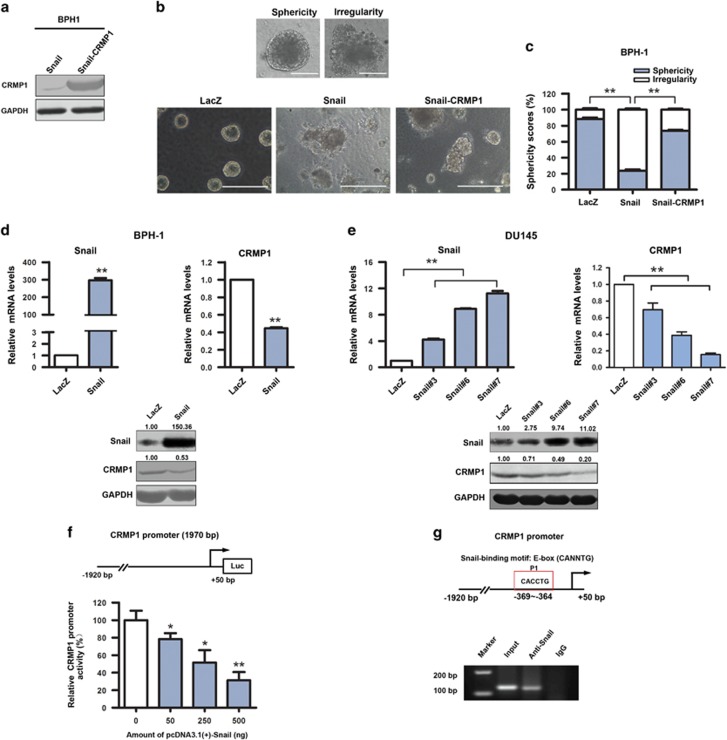Figure 6.
(a–c) CRMP1 confers resistance to Snail-induced EMT in BPH-1 prostatic epithelial cells. (a) Immunoblot of CRMP1 expression in BPH-1-Snail and BPH-1-Snail-CRMP1 infectants. (b, c) Three-dimensional (3D) culture assay and scoring analysis of spherical 3D spheres (sphericity) or irregular aggregates (irregularity) formed by the BPH-1 infectants. (b) Top: Representative phase-contrast images of a regular sphere with smooth contour (sphericity) and an irregular aggregate (irregularity) formed by the BPH-1 infectants. Bars, 1 μm. Bottom: Representative images of spheres and irregular aggregates formed by LacZ (control), Snail and Snail-CRMP1 infectants. Bars, 5 μm. (c) Scoring analysis showed that both the BPH-1-LacZ and BPH-1-Snail-CRMP1 infectants formed mostly regular spheres (with sphericity scores of 88.4 and 73.6%, respectively), as compared with BPH-1-Snail infectants that formed considerably less regular spheres (sphericity score of 23.6%). Data are presented as mean±s.d. from three independent experiments performed in triplicate. **P<0.01. (d–g) Snail acts as the direct repressor of CRMP1 gene. (d, e) Reverse transcriptase–PCR and immunoblot analyses of CRMP1 expression in BPH-1-Snail and DU145-Snail infectants. Results showed that both BPH-1-Snail and DU145-Snail infectants showed significant reduction of CRMP1 expression, as compared with control LacZ vector-transduced cells. Figures shown above the immunoblots indicate the relative levels of Snail and CRMP1 expressed in infectants. **P<0.01 versus LacZ vector-transduced cells. (f) Luciferase reporter assay of CRMP1 gene promoter performed in HEK293FT cells. CRMP1-Luc reporter, driven by the proximal CRMP1 promoter, was significantly repressed by Snail in a dose-dependent manner. *P<0.05, **P<0.01 versus empty vector-transfected cells. (g) Chromatin immunoprecipitation assay performed on CRMP1 gene promoter in HEK293FT cells transfected with pcDNA3.1-Snail. Top: Diagram shows the location of Snail-binding site or E-box identified in the proximal CRMP1 promoter. A 146-bp fragment could be PCR-amplified in anti-Snail-immunoprecipitated DNA but not IgG-immunoprecipitated DNA in Snail-transfected HEK293FT cells.

